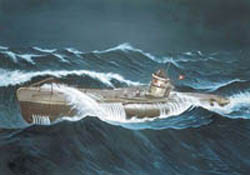 Imagine
the tension of constantly fearing discovery, using your most sophisticated
evasion tactics and techniques to avoid ever-watching eyes, knowing that reprisals
will be both swift and brutal should your U-boat be detected. Just trying
to sneak your new Revell 1:72 U-boat kit past your partner - in a box that's
almost a metre long - is the surest way I know to really put myself in the
mindset of those who once crewed the original vessels!
Imagine
the tension of constantly fearing discovery, using your most sophisticated
evasion tactics and techniques to avoid ever-watching eyes, knowing that reprisals
will be both swift and brutal should your U-boat be detected. Just trying
to sneak your new Revell 1:72 U-boat kit past your partner - in a box that's
almost a metre long - is the surest way I know to really put myself in the
mindset of those who once crewed the original vessels!
For Winston Churchill, the closest the United Kingdom came to
suing for peace with Nazi Germany was at the height of the U-boat blockade
of 1941-42, when shipping losses were far exceeding tonnage built and severe
shortages of essential supplies were looming. The Type VII was the most numerous
of the U-boats, with just over 700 completed (almost all Type VIIC), these
submarines were considered a very successful compromise  between
the range of the larger Type IX boats and the speed and manoeuvrability of
the earlier Type II class. The Type VII was designed to operate in the crucial
North Atlantic sea lanes and it was these submarines that formed Admiral Dönitz's
'wolf packs' that were so feared by allied merchant and naval seamen, at least
until the turning of the Battle of the Atlantic in 1943.
between
the range of the larger Type IX boats and the speed and manoeuvrability of
the earlier Type II class. The Type VII was designed to operate in the crucial
North Atlantic sea lanes and it was these submarines that formed Admiral Dönitz's
'wolf packs' that were so feared by allied merchant and naval seamen, at least
until the turning of the Battle of the Atlantic in 1943.
The Kit
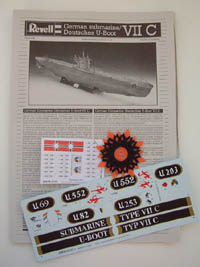 There's
no other way to say this: it's big. Revell of Germany's offering is just a
tad over 93 cm in length, with the two hull halves coming as full-length units.
These dwarf, by a considerable margin, the largest kit previously in my collection,
namely the Monogram 1:72 B-36 Peacemaker. In addition to the hull sections,
there are approximately 120 smaller parts comprising the decks, conning tower,
stand and myriad smaller details, all perfectly cast in pale grey plastic
with no flash whatsoever. The box also contains a spool of rigging thread,
a large decal sheet (mainly for the stand), a smaller sheet of paper transfers/flags
and a 28-page A4-size instruction booklet.
There's
no other way to say this: it's big. Revell of Germany's offering is just a
tad over 93 cm in length, with the two hull halves coming as full-length units.
These dwarf, by a considerable margin, the largest kit previously in my collection,
namely the Monogram 1:72 B-36 Peacemaker. In addition to the hull sections,
there are approximately 120 smaller parts comprising the decks, conning tower,
stand and myriad smaller details, all perfectly cast in pale grey plastic
with no flash whatsoever. The box also contains a spool of rigging thread,
a large decal sheet (mainly for the stand), a smaller sheet of paper transfers/flags
and a 28-page A4-size instruction booklet.
The latter is very detailed and relatively clear to follow, but as you are given various options for the final submarine, there are multiple choices and construction sequences illustrated. I would suggest choosing your option at the beginning and systematically crossing out the non-appropriate boxes to avoid confusion before you put a scalpel or glue anywhere near plastic. The decals also look fine but are fairly limited; most U-boats carried minimal markings and once the shooting war began they did not generally wear their number on the side of the conning tower (whatever the comic books you read as a kid showed you!).
Based on my references, the shapes and dimensions of the kit match up extremely well against the original, with an impressive amount of small detail being captured. The flooding holes in the decking are a case in point: the pattern exactly replicates that of an early-war Type VIIC boat and looks most authentic. The rivets and weld seams on the sides of the hull are raised, but perhaps a little too much so, and could probably benefit with tips from armour modellers as to making them appear more authentically welded.
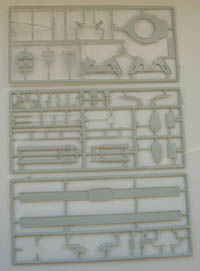 One
dilemma for many modellers will be what to do with the flooding holes on the
decking and upper sides of the hull. The latter in particular are quite prominent
on the real thing, and probably should be opened up. While they could be drilled
out one by one, my suggestion would be to sand or Dremel the whole area from
inside to thin the plastic until the holes appear. The kit is sturdy enough
to take this, but to do so would then mean you would probably need to replicate
the cylindrical surface of the main hull beneath these holes, plus the many
items such as torpedoes, rafts and ancillary equipment stored in this space.
Personally I think the upper decking would be fine with a good wash of your
favourite black paint and would be considerably weakened if you were mad enough
to open up all of the holes.
One
dilemma for many modellers will be what to do with the flooding holes on the
decking and upper sides of the hull. The latter in particular are quite prominent
on the real thing, and probably should be opened up. While they could be drilled
out one by one, my suggestion would be to sand or Dremel the whole area from
inside to thin the plastic until the holes appear. The kit is sturdy enough
to take this, but to do so would then mean you would probably need to replicate
the cylindrical surface of the main hull beneath these holes, plus the many
items such as torpedoes, rafts and ancillary equipment stored in this space.
Personally I think the upper decking would be fine with a good wash of your
favourite black paint and would be considerably weakened if you were mad enough
to open up all of the holes.
Two styles of bridge are supplied which - along with the optional net cutter on the bow and the open-or-closed torpedo tube doors - are essentially the variations you can make from this kit. It is important to note that this kit cannot be easily converted back to a Type VIIB (e.g. Gunther Prien's infamous U-47 which penetrated the British fleet base at Scapa Flow), as that type was 60 cm shorter than the VIIC, with the change occurring right through the bridge area. Similarly, to alter the kit to a later-war Type VIIC - without the deck gun but with extra anti-aircraft defences - would require not just a new bridge and additional armament, but also a new deck pattern where the 88 mm used to be. Therefore, if you wish to build a specific U-boat you will need to research it carefully to see exactly which version it was and when it was operating, or major (and fiddly) surgery could be required.
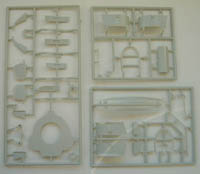 Larger
issues aside, the detail on the smaller parts is good for an injection-moulded
kit, with the deck cannon in particular really looking the part. All of the
railings are supplied and appear to be in scale (whereas photoetch would look
positively 'wiry' on a kit this scale), although in my kit the 'wintergarten'
railing around the anti-aircraft gun was smashed in transit. The stand is
functional but nothing to write home about, and I assume most ship modellers
have their own preference for how to mount a kit such as this.
Larger
issues aside, the detail on the smaller parts is good for an injection-moulded
kit, with the deck cannon in particular really looking the part. All of the
railings are supplied and appear to be in scale (whereas photoetch would look
positively 'wiry' on a kit this scale), although in my kit the 'wintergarten'
railing around the anti-aircraft gun was smashed in transit. The stand is
functional but nothing to write home about, and I assume most ship modellers
have their own preference for how to mount a kit such as this.
While the size of the box may be daunting, it looks like the build of this kit will actually be relatively straightforward; given that they were streamlined for underwater travel, submarines have far fewer excrescences than a surface vessel. This will really leave only two problems: how to paint and weather it authentically, and how (and where!) to display it.
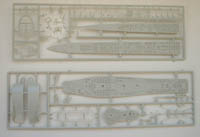 Conclusion
Conclusion
All in all Revell should be commended for their audacity in producing
this fine kit, which represents good value (and promises lots of fun) for
the price. If your evasion techniques - or failing that, your surrender negotiations
- are up to scratch, I'd absolutely recommend this kit to anyone with a spirit
of adventure and a lot of storage space.
I bought my U-Boat from Sandle Hobbies
Reference: Stern RC. Type VII U-boats. London: Brockhampton Press, 1998.
Copyright © SMML 2004